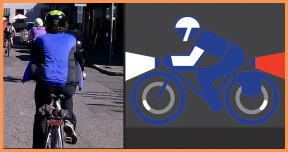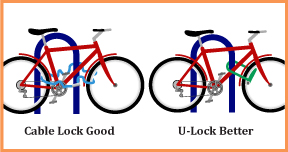Top Five Safety Tips
Follow the Rules of the Road
- Ride with traffic and obey all regulatory signs and traffic signals. By law, bicyclists are required to ride in the same direction as automobile traffic.
- Act like a car and obey the same laws as motorists.
- Use the rightmost lane that heads in the direction that you are traveling.
Be Predictable
- Use hand and arm signals to indicate your intention to stop, merge or turn. Signal as a courtesy and for safety as required by law.
- Whenever possible, ride in a straight line, to the right of traffic, at about a car doors width away from parked cars.
- Avoid sidewalks. Motorists don’t expect bicycles on sidewalks, and pedestrians on foot have the right-of-way on sidewalks and other walkways. If forced to ride on the sidewalk, cross driveways and through crosswalks at a walker’s pace and look carefully for traffic before proceeding (especially look out for turning traffic at intersections). No bicycling is allowed on the sidewalks in Salt Lake City’s downtown Central Business District.
Be Visible
- Ride where drivers can see you.
- Wear bright colored clothing during the day and light-colored or reflective clothing at night.
- Always use a strong headlight and tail light and good reflectors when riding at night as required by law.
Be Alert
- Be extra alert at intersections: watch for turning vehicles and vehicles exiting driveways.
- Make eye contact with drivers. Assume they do not see you until you are sure they do.
- Be aware of traffic around you and be prepared to take evasive action.
- Learn braking and turning techniques to avoid crashes.
- Avoid road hazards. Watch for storm drain grates, slippery manhole covers, oily pavement, gravel and ice. Cross railroad tracks at right angles.
- Don’t get distracted: don’t listen to music or talk on the phone while riding.
Ride with proper equipment
- Wear a helmet.
- Check your brakes and wheels. Make sure the wheels are properly secured and brakes are functioning correctly.
- Purchase the best locking system you can afford. Lock the frame and front wheel to a fixed object.
Navigating Intersections
Most crashes between cars and bikes occur at intersections. These crashes may occur when a car turns across a bicyclist’s path, or a bicyclist fails to obey a stop sign or signal. The tips below will help keep you out of trouble at intersections.

Never Ride Against Traffic
As a bicyclist, ride on the right side of the road. Riding against traffic is especially dangerous at intersections. By law, bicyclists are required to ride in the same direction as automobile traffic. Utah Statute 41-6a-1105.
Depending on your destination, use the appropriate travel lane at the intersection – the right-turn lane if you are turning right, the right-most through lane if you are going straight, or the left-turn lane if you are turning left. If you are not comfortable with the traffic at the intersection, you may use the sidewalk or crosswalks at walking speed.

Going Straight
Drivers at intersections may not see you. Make eye contact with turning drivers. Sometimes it’s even a good idea to wave (all five fingers, please). Assume they don’t see you until you’re sure they do.
As you approach the intersection, look for traffic at these three conflict points:
- Look back over your shoulder for traffic behind you. If there is no traffic behind you, you may wish to move slightly left (into the travel lane) for visibility going through the intersection. When stopped at a red light, stay to the left of cars turning right.
- Look for left-turning traffic ahead of you. Motorists turning left may not see you, especially at night. If there is no traffic behind you, move further left in the travel lane to be in a visible location. At night, a front light is both smart and required by law.
- Look for right-turning traffic from the street on your right. As with left-turning traffic, using a headlight at night and riding further left will increase your visibility.

Turning Left
Vehicle-style left turn – Look back. If the way is clear, signal and move to the left lane. Turn left from the left side of the street or the dedicated left-turn lane, if available.
Pedestrian-style left turn – You may also turn left in two steps. Ride to the far side of the intersection, then wait and cross with pedestrians after the signal changes.
Signal Your Turns
Bicyclists should use hand signals as shown. Practice dropping one hand from the handlebars while steering straight. The law provides that you do not have to signal if you need to use your hands to steer or brake. Utah Statute 41-6a-1109.
If You’re Involved in a Crash
- Make sure you are okay; go to the hospital if in doubt.
- Call the police (911) and get a police report at the scene.
- Write down the details of the incident. If you have a camera, take photos. Get names and contact information from any witnesses.
- If you are hurt, you can file a Personal Injury Protection (PIP) claim, with either your auto insurance or the car driver’s insurance (regardless of who is at fault). Auto insurance covers you for certain types of crashes on your bike. You may also consider hiring a personal attorney.
Gear and Equipment
Wearing a bicycle helmet is smart, whether you ride in traffic or on a trail. Helmets are required on most organized bicycle rides, but are not required by law. When you buy a helmet, look inside to make sure it has a sticker from the Consumer Products Safety Council (CPSC).
Check your helmet fit
Bicyclists of all ages can make sure a helmet fits by doing the Eyes, Ears, Mouth test:
 Eyes: Start by making sure the helmet fits comfortably on your head, but not too loosely. Place the helmet on your head level with your eyebrows.
Eyes: Start by making sure the helmet fits comfortably on your head, but not too loosely. Place the helmet on your head level with your eyebrows.
 Ears: Adjust the straps to form a Y under each earlobe. Poorly-adjusted straps are a common cause of the helmet sitting too far back on the head.
Ears: Adjust the straps to form a Y under each earlobe. Poorly-adjusted straps are a common cause of the helmet sitting too far back on the head.
 Mouth: Tighten the chinstrap so you can just slip two fingers under the helmet. When you open your mouth wide, you should feel your helmet tighten on the top of your head.
Mouth: Tighten the chinstrap so you can just slip two fingers under the helmet. When you open your mouth wide, you should feel your helmet tighten on the top of your head.
 The helmet should sit level on your head and be snug. As with any article of clothing, helmets are more comfortable if they fit you and are adjusted correctly.
The helmet should sit level on your head and be snug. As with any article of clothing, helmets are more comfortable if they fit you and are adjusted correctly.
After a crash or any impact that affects your helmet, visible or not, replace it immediately.
Lights

State law requires a white front light from dusk to dawn. This is a requirement in all 50 states and is also a smart idea since most crashes occur from the front, especially in an urban environment.
A red rear reflector or red rear light (either flashing or solid) is also required. Reflectors visible to the sides are also required, unless your headlight has sidelights. Utah Statute 41-6a-1114.
Locks

As bicycling becomes more popular in a community, bicycles become more desirable. This can lead to an increase in bicycle theft. To prevent bicycle theft, bicyclists are advised to use a good lock. An unattended, unlocked bicycle is its own getaway vehicle!
A U-lock is recommended for locking the front wheel and triangle of the frame to a solid fixed object (such as a bicycle rack). If you don’t want to carry the weight of a full size U-lock, consider using a mini U-lock (but learn to use it correctly). Cable locks are more easily cut than U-locks.
Bicycle Registration
Register your bike online at SLCPD’s website. If your bike ever gets stolen, this process makes reporting it easier and increases the likelihood of it being returned to
